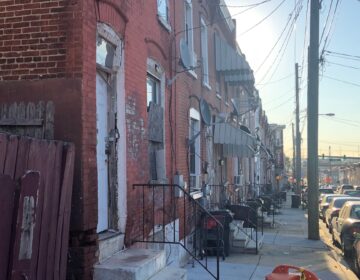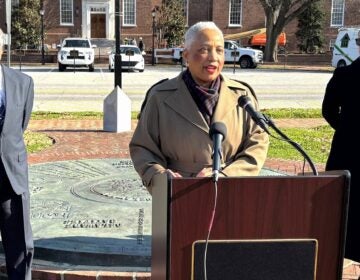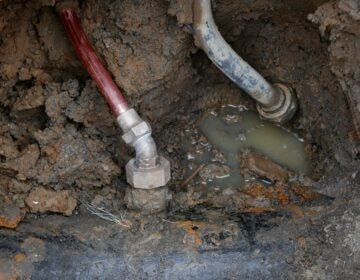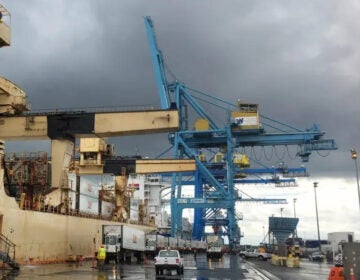As major I-95 construction starts in Wilmington, a look back at the road that split the city
Drivers in and around Wilmington will face plenty of backups, but that pales to the disruption the highway caused in city neighborhoods when it was first built.
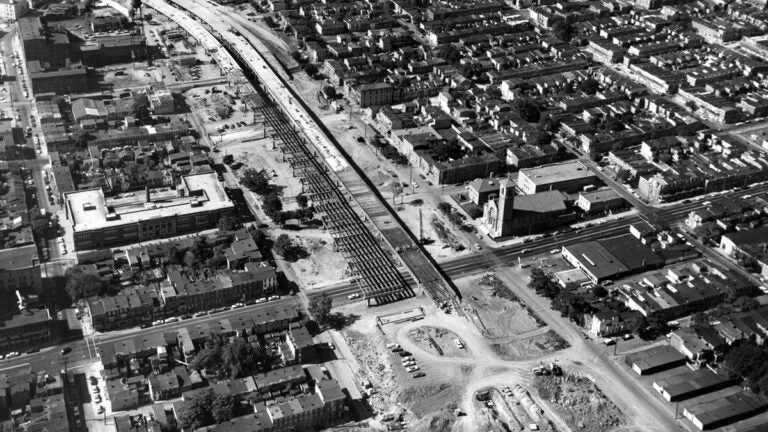
Construction work approaches 4th Street in September 1965. On the lower right, St. Paul's Catholic Church narrowly avoided the path of the interstate. (Courtesy of Delaware Public Archives)
Two years of major construction is now underway on a four-mile section of I-95 that runs through Wilmington.
Starting March 1, the northbound lanes of the highway will be shut down, and drivers heading north will be shifted to what is typically the southbound side. Both north and southbound traffic will share the southbound side with each direction reduced to one lane. This fall, the pattern will shift with drivers in both directions sharing the northbound side.
The work includes repairing 19 bridges including the mile-long Wilmington viaduct over marshy ground south of the city. DelDOT says doing these repairs now could extend the life of these bridges by at least 30 years.
All lanes of the highway won’t reopen until Fall 2023.
With the highway’s limited capacity and multiple off-ramps shut down, DelDOT has warned of major delays for the 100,000 vehicles that typically travel along that route every day.
To help mitigate the delays, DelDOT is hoping to get 25% to 30% of travelers to take an alternate route around Wilmington via the simplest alternative, I-495. The department has also installed remote controls on more than 200 traffic signals in Wilmington which can be used to manage the flow of traffic from the state’s Traffic Management Center in Smyrna.
While the next two years will bring headaches and backups to both commuters and Wilmington residents who live near the interstate, it won’t compare to the upheaval the initial construction of the highway caused in the 1950s and ’60s.

As the interstate construction south of Wilmington cut through farmland and accelerated the growth of suburban sprawl, thousands of city residents saw their neighborhoods changed forever.
The wrecking ball proved to be an unstoppable destructive force, impacting both upscale neighborhoods near the Brandywine River and working-class homes further south. Churches, stores, a brewery, and more all fell in the name of transportation progress. Several thousand residents were bought out of their homes to make way for the interstate.

“It really did cut across a whole spectrum of people and communities,” Sam Seo said.
Seo has been researching the impact of the highway construction on the city as part of his graduate studies at the University of Delaware’s Biden School Public Policy and Administration.
Once the buildings were cleared, city residents were left with a massive trench that formed a canyon through the city.
“It really was kind of a war zone that people were incredibly unhappy with,” Seo said. “The reality was setting in that this was going to alter the community and the landscape in a really profound way.”

The demolition claimed the buildings of St. Paul’s Methodist Church and Zion Lutheran Church.
“These were two very large very beautiful churches that were demolished,” said Josh Solge, who teamed up with Seo for the research at UD. “A lot of these churches had hundreds of families displaced by the process.”
Two Catholic churches were just outside of the highway’s path, but that didn’t spare them from the effects either. Large portions of their congregations were among those forced to move.
A big landmark, that would have been a prime location to take advantage of the growth of microbrewing, was also lost in the construction.
From 1882 until 1962, a massive 11-foot-tall zinc statue stood on one of the tallest buildings in Wilmington at the time: the Diamond State Brewing Company building at 5th and Adams streets. The brewery was situated at one of the highest points in Wilmington, meaning the statue depicting the fictitious beer god Gambrinus could be seen from all over the city.
“You can imagine this piece of that brewing heritage in the city. If that were still here, [it] would be such an icon,” Solge said. “It’s just this architectural heritage of the city that was kind of discounted at the time, but now you look at photos of these buildings and it’s like ‘I wish that was still there.’”
Residents who lived near the construction zone lost much more than just iconic architecture. They lost neighbors, friends, and classmates who moved away. They also lost their connection to the rest of the city.
“Just think of how much we’ve lost by cutting across the city like that, in terms of being able to move around,” Solge said. “Being able to walk to the local store, walking to a little local soda fountain or local institution and not hav[ing] to drive around like you would have to in the suburbs.“
As workers demolished a wide swath through the western part of downtown Wilmington, they created a neighborhood divide that’s still being felt today.

“I think that there’s definitely still a deep feeling of that separation,” Sarah Lester said. “It’s a real separation, I-95, but it’s also solidified some kind of special, West Side-versus-West Center City [division] that we’re really working to connect again.”
She led a 2019 effort to reconnect neighbors across the highway through an initiative called United Neighbors as part of the West Side Grows community organization.
At the time, the highway project was pitched to residents and city leaders as a solution for the city’s waning status as a hub of activity for residents in New Castle County, but it didn’t quite work that way, Seo and Solge found.
“There was definitely a story of decline being told about Wilmington at the time and I-95 was looked at as a tool to reverse that. That it would turn Wilmington into this draw and bring people into the city,” Solge said. “I think the reverse was the case. It acted as an accelerant of that decline and pulled people out of the city.”
Wilmington’s population was already falling from its high in the 1940s when more than 112,000 lived in the city. By the 1960 census, the city’s total population was 95,827. The population was down to 80,386 by 1970 and the city shed another 10,000 residents by 1980 for a population of 70,195.
“The ultimate proof of, ‘Was this good thing for these neighborhoods or not?’ is that everybody who was in these neighborhoods left,” Solge said. “The people who lived there 50-60 years ago, almost universally up and left.“
As the major construction project to extend the life of the highway gets underway, Seo and Solge will continue their research in hopes of eventually publishing their work in an academic journal.

Get daily updates from WHYY News!
WHYY is your source for fact-based, in-depth journalism and information. As a nonprofit organization, we rely on financial support from readers like you. Please give today.




